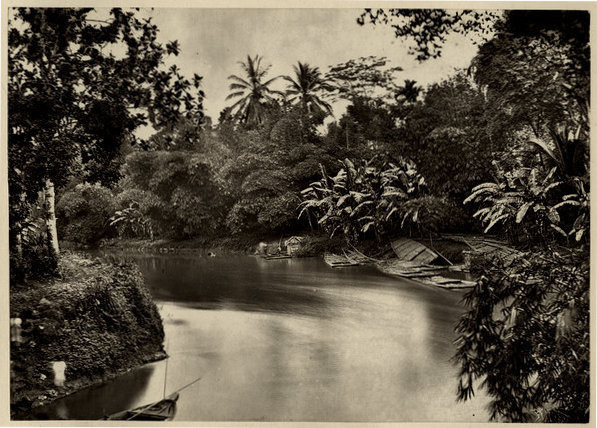|
Russel Wallace : Alfred Russell Wallace (sic)
Returning now to our river scene, let us describe the more remarkable forms of vegetable life which it presents. The large tree which stands on the left bank, and rises to the top of the picture, is the celebrated bread-fruit tree (Artocarpus incisa), a native of the islands of the Pacific, but which has been long cultivated in the Malay Archipelago. The two palms whose heads occupy the centre of the view are cocoa-nut trees, and the dense mass of drooping feathery vegetation beneath them is a thicket of bamboos--gigantic tropical grasses which, when forming isolated tufts 80 or 100 feet high, are, perhaps, the most beautiful and graceful of all plants. In the lower right-hand corner a spray of bamboo comes in the foreground, while several bamboo rafts are seen in the water and on shore. Immediately to the right of the cocoa-nut palms is one of the silk-cotton trees belonging to the natural order bombaceæ, whose seeds are so thickly surrounded by a beautiful silky down, that bushels of it can be gathered [[3rd unnumbered page]] when the fruits burst open and the cotton falls to the ground. To the right of this again is another palm called the aren, and, by botanists, Arenga saccharifera. It is highly prized by the Malays, since it yields wine, sugar and cordage. When the flower-stem is cut off, a great quantity of sweet sap flows out for weeks together. Slightly fermented, this is palm wine, a refreshing drink like new beer or cider. If the fresh juice is boiled, it yields a dark-coloured but very excellent sugar; while the leaf-stalks are thickly clothed with stiff, black fibres, which are woven into cordage for use in the native boats. The great leafy tufts that rise from the bank on the right-hand side of the picture are bananas, the Musa paradisaica of botanists, a plant that was believed by Humboldt to yield more food for man from a given space of ground than any other vegetable. Close above the right-hand tuft of bananas is a palm, like a stiff plume of feathers. This is a young sago palm, the pith of whose stem consists almost wholly of sago intermixed with a little fibrous matter. Our illustration, therefore, shows us no less than seven of the most useful, beautiful, and curious tropical plants; and if the reader will imagine an undergrowth of dwarf palms, and ferns, and glossy-leaved vegetation, all in the most vigorous and luxuriant growth, under the influence of constant showers and intense sunlight; brilliant birds flitting among the trees; numerous butterflies fluttering lazily, now in sunlight, now in shade; shining lizards creeping noiselessly about; and the constant hum of insects filling the air, they will be better able to picture for themselves that living reality of a tropical landscape, which even the truthful photograph can only imperfectly represent. Alfred R. Wallace.
|

